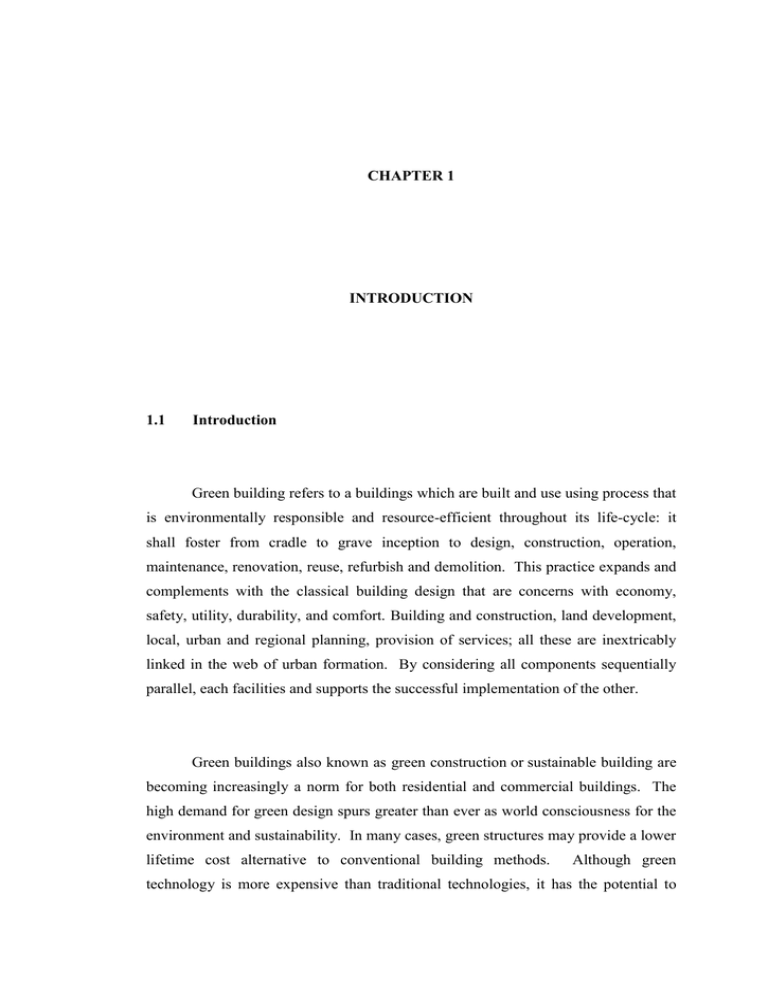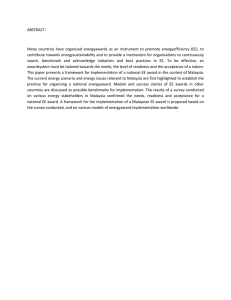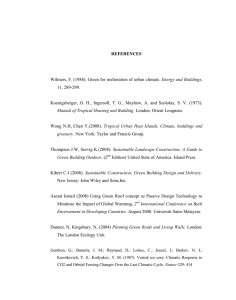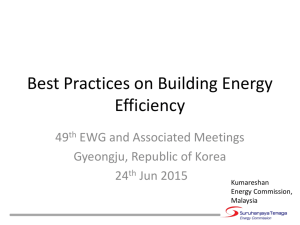CHAPTER 1 INTRODUCTION 1.1
advertisement

CHAPTER 1 INTRODUCTION 1.1 Introduction Green building refers to a buildings which are built and use using process that is environmentally responsible and resource-efficient throughout its life-cycle: it shall foster from cradle to grave inception to design, construction, operation, maintenance, renovation, reuse, refurbish and demolition. This practice expands and complements with the classical building design that are concerns with economy, safety, utility, durability, and comfort. Building and construction, land development, local, urban and regional planning, provision of services; all these are inextricably linked in the web of urban formation. By considering all components sequentially parallel, each facilities and supports the successful implementation of the other. Green buildings also known as green construction or sustainable building are becoming increasingly a norm for both residential and commercial buildings. The high demand for green design spurs greater than ever as world consciousness for the environment and sustainability. In many cases, green structures may provide a lower lifetime cost alternative to conventional building methods. Although green technology is more expensive than traditional technologies, it has the potential to 2 have a shorter return of investment due to significant reduced of utility bills. With the current economic condition, cost-effective designs will certainly drive the market forward. The idea of green design is still a new concept. Therefore, the definition of what is, and what is not green has sometimes confusing. However, there are many emerging ways to define a green design. In Malaysia, rating system for green design called GBI has existed. GBI (Green Building Index) was developed by the PAM (Malaysia Architect Associate) and provides a checklist to achieve sustainable building design. Features in the checklist include a range of construction aspects from site selection, to energy sources, to materials of construction. Energy-efficient appliances, alternative heating/cooling sources, solar energy and water conservation are all contribute to what is widely considered to be green. (Ministry of Energy, Water and Communications, MEWC, 2010) A well-planned and designed built environment will consider the natural environment and able to validate its importance for wellbeing. The human built environment must be the one that supports ongoing wellness and integrity of the natural environment as well as the individuals and society, far maintaining social and economic prosperity. The sustainability of our built environment, and our physical health and emotional wellbeing is intrinsically linked to the quality of the environment. 1.2 Research background A capital at large requires to build a green buildings. When compared with the lifetime of the ordinary buildings, this building is to save the overall costs. Malaysian government is appreciating the potential of green technology sector and 3 allocated approximately RM 1.52 billion under 2010 budget to promote and encourage the growth of the industry. These enable companies of green technology to have a financial borrowing capacity to finance their activities. For supplies, the maximum loan of RM50 million can be made and RM10 million for end users of buildings. Government has also provided various incentives such as in the form of tax allowance, exemption from import duty and sales tax for building which have been recognized as Green Building Index (GBI). (Chin, PFK 2009) The construction sector stands as a focus of global efforts to reduce its “carbon footprint” has started to gain traction with startling speed, though in reality, the forces propelling the greening of real estate have been mounting for at least a decade. Some construction practitioners have long advocated greener approaches to how and where property is developed and operated, but a new paradigm seems have to be reached by critical mass beside awareness to action. Industry publications, conferences and popular press are suddenly filled with account of how developers can and how to produce more environmentally-friendly high performance product. The near ubiquitous motto is: “Green is Green”. The construction industry has always had its core of practitioners who recognize the special responsibility to the sector for built environments. But it has been only in the last few years that these voices have gained wider attention within the construction and real estate community. Now, organizations across the construction spectrum are recognizing the importance of addressing the environmental challenges. 4 1.3 Problem statement The 9th Malaysian Plan was launched in the early of 2006, that include sustainability aspect of development that sets the tone for development over the subsequent 5 years (2006 – 2010). The Malaysian government, in its recent five year 9th Malaysian Plan emphasizes the following:- The importance of EE (Energy Efficiency) initiatives in Residential, industries, transport and commercial sectors as well as government buildings. The development of Renewable Energy (RE) and the Enhancement of energy efficiency (EE) will be fore fronted by the Ministry of Energy, Water and Communications (MEWC). Based on the current Malaysian Plan, it can be seen that action taken on the application of sustainability is more towards the development of Renewable Energy (RE) and Energy Efficiency (EE) initiatives in residential buildings, which is one of the elements of sustainable or green building. This effect seen as various housing estates in Johor are categorized as „sustainable‟ or „green‟ but the adoption is unplanned and uncoordinated by the local authority and fragmented in only parts of Pulai spring, Setia Tropika residential and some area in Johor Bharu. In Malaysia, the green buildings are under 5 year‟s life span. Malaysia is also behind in the application of green building, and there is no client rating system available for resident to encourage the assessment to their own buildings. The governance structure of green initiatives such as the administration, management and the policy is still in installation format. Considering the previous fact, this research is an effort to contribute an ideas for better green building application in the future at developing governance level of structure in green building application. This research will be addressing this issue through the questions as stated below:- 5 (1) What is the level of knowledge among resident about green building practices in construction? (2) Was it other ways to assess green building index for residential building and how to assess it? (3) What are the difference and benefit between self assessment of green building index and professional assessment? 1.4 Research Objectives This proposed research seeks to achieve the following objectives: (1) To check the level of knowledge among resident in green building practices in construction. (2) To develop a guideline for self assessment of green building index. (3) To contrast between the self assessment green building index to an existing green building index attribute in Malaysia. 1.5 Research scope In this context, scoping refers to the geographical and respondent scope. The geographical scope is limited to resident with single and double storey housing near Johor Bharu, Johor Darul Takzim, to build the self assessment guidelines, the respondent of green building resident and professional selected. 6 1.6 Significance of the Research The outcomes of this research are to reveal the household of their knowledge level about green building. The community needs to be alerted and be prepared to meet the outcomes of the building they choose to live and to provide better places for the future generation. The second contribution of this research is to propose a self assessment of green building index form for the resident. This idea is important as it provide the decision maker with the framework on how the green building should be manage at granular level of society. Another important contribution of this research is to compare the different between self assessment index with professional index. Outcomes from this self assessment will provide knowledge on where green building in Malaysia is headings. By knowing where our self is positioned, foster further actions to be identified and mitigate to fulfill the needs of the applications on the holistic concept of green building. 1.7 Research methodology The realization of this research considers the following methodology: (1) Literature revision on element of green building. (2) Diagnosis of current green building situation and concept in Malaysia such as guidelines, policy and intensives available and develop quantitative form. 7 (3) Develop the research instrument. Semi-structured questionnaire will be developing to assist in developing a self assessment green building index in Malaysia. (4) Analyzing the information collected from self assessment using Statistical Packages for Social Science (SPSS) (5) Generation of a self assessment on the resident in Malaysia context. (6) Compared the professional marking of forms with self assessment marking and concluded with some recommendation. 8 Problem formulation Identify research questions and objectives Literature review Malaysian GBI International Index Develop a conceptual framework for assessment Data collection Primary - Pilot Survey - Unstructured Interview - Questionnaire Survey - Field Observations Secondary -Books -Journal -Document Review Data analysis Research finding, recommendations & conclusions Reporting Figure 1.1: Flow chart for research methodology 9 1.8 Arrangement of the report 1) The First Chapter is the introduction of the study includes the problem statements, the aim and objectives of the study, the scope of work and the methodology of study. 2) The Second Chapter is on literature review which focused on the green building definition, concept of green building, impact of green building, assessment green building index available and benefit of green building. 3) The Third Chapter describes about the method of study and data analysis. 4) The Fourth Chapter discusses the results and data analysis of the study. 5) The Fifth Chapter includes the conclusion of the study and some recommendations for the future study. 1.9 Case Study Setia Tropika is a township that claims on innovation to provide a lifestyle that is above the rest. Setia Tropika is a showcase of modern-day living at its best with the perfect combination of chic, contemporary home designs set within landscaped greenery. Spread across 740 acres of prime land, Setia Tropika‟s most defining features are its groundbreaking designs that lend the homes a contemporary modernistic twist yet remain functional for family living. Among the striking architectural elements are rooftop garden terraces, indoor water features, built-in courtyards and double volume porches. 10 Being touted as one of the fast-growing development in Johor Bahru, Setia Tropika, since its inception 5 years ago, currently has more than 2,500 units of occupied residences and commercial lots. Setia Tropika also developed the CBD (Central Business District), an integrated flagship commercial hub of the township that offers total conveniences and amenities to the residents of Setia Tropika as well as the general public. The Setia Tropika township is situated next to the North-South Highway, which has a projected traffic flow of 6,000 cars every hour. Setia Tropika has built the Exit 255B for its residents so that they can travel to and from the CBD faster and easier. The construction of the new EDL (Eastern Dispersal Link) is currently in progress and is estimated to completed by 2011. The EDL connects the North-South Highway to the new Customs, Immigration and Quarantine Complex (CIQ) reducing the traveling time to the CIQ to only 10 minutes. This thriving township also extensively embraces the "Green Street" development concept to ensure a conducive living environment for its residents. With a 12-acre town park forming the heart of the vibrant township, residents can enjoy various features of signature Setia landscaping such as playground, reflexology path, amphitheatre and mini parks. 11 Figure 1.2: Type of double storey house (Licuala Ray) Figure 1.3: Type of double storey house (Licuala Lush)






